Pedagogy
Step into the Malay Heritage Centre (MHC)’s permanent exhibition on the
first floor and you will hear birds chirping away in the space. That is the sound of ‘Birds of
Paradise’, one of the features in the Children’s Space - Adventures in Nusantara, launched
as part of MHC’s special exhibition ‘Seekor Singa, Seorang Putera dan Sebingkai Cermin (A
Lion, A Prince and A Mirror): Reflecting and Refracting Singapura’, organised as part of the Singapore
Bicentennial.
Adventures in Nusantara is based on the stories of three
young historical characters - Hang Nadim, Ali Wallace and Wah Hakim. It is MHC’s first attempt to create a
dedicated experiential space for children aged three to six years old and is premised on narratives taken from
the ‘Nusantara’ (a Malay word with Javanese roots that refers to the Malay archipelago).
Through various interactive areas in the space, young audiences can learn about these narratives and relate to
the encounters of these young noble characters through active and meaningful exploration.
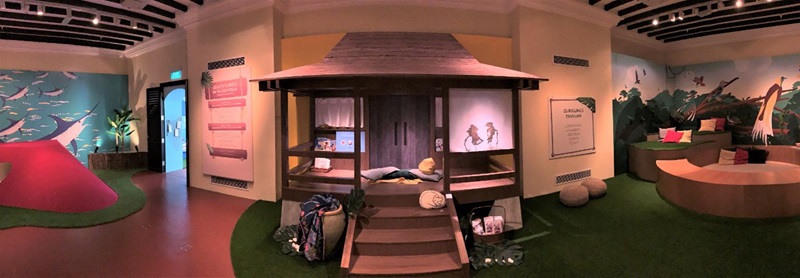
With every exhibition, MHC considers how we can cater to and engage various
audiences meaningfully. Mindful that every visitor has different motivations when they visit the museum, MHC has
a suite of offerings which includes guided tours, performances, workshops and activity booklets. For ‘Seekor Singa, Seorang Putera dan
Sebingkai Cermin (A Lion, A Prince and A Mirror): Reflecting and Refracting Singapura’, MHC
recognises that there is a group with much more potential for engagement and these are our young audiences.
Opportunities to engage young audiences in museum settings are ideally achieved
through the design of conducive environments that allow for knowledge acquiring through play and hands-on
learning. Hence, a decision was made to convert the Finale Gallery, a dimmed gallery space that was previously
used to screen commissioned films.
Interactive explorations are a creative way of communicating ideas and concepts to
young audiences. It is vital for children to take on an active role and ownership through these explorations,
which makes for a much richer and personalised experience. An environment that promotes play and exploration
also provides opportunities for children to develop critical developmental skills and knowledge in an informal
learning setting. Thus, MHC saw this as an opportunity to start introducing our culture and heritage to children
from a young age within the setting of a museum. While making sense of the world around them, they can also
acquire information about the local context, which they can draw upon through their developmental years. This
will in one way or another, have an impact in their future endeavors.
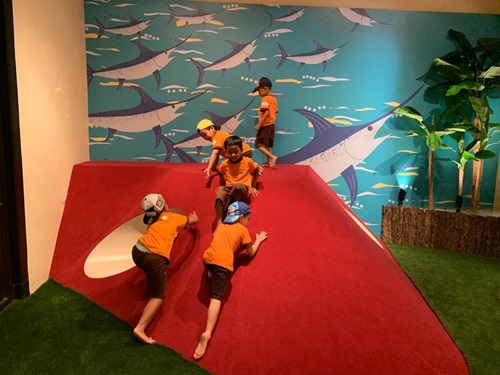
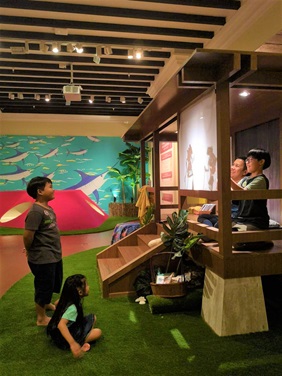
MHC sought a partnership with an industry partner with a similar vision and The
Artground (TAG) came to mind. TAG is managed and nurtured by The Ground Co Limited, a registered arts
charity located at Goodman Arts Centre. They aim to provide positive arts experiences across a variety of art
forms for children from birth to nine, in an accessible space that welcomes children from every community.
Together, MHC and TAG came up with the idea to introduce spaces that are not only
multipurpose, but charming in their own ways and can effectively deliver heritage narratives within the pedagogy
of the space.
Design and Installation
MHC is housed in the former Istana Kampong Gelam, which is a national monument gazetted in 2015. Hence during the process of conceptualising and designing the interactives, MHC and TAG had to bear in mind the regulations and guidelines to be adhered to, thus posing certain challenges to the installation of the Children’s Space.
For visitors who are unfamiliar to the Malay Heritage Centre, the narrative of the permanent galleries is modeled after the flow of a traditional Malay house: visitors start by walking through the second floor, followed by the first floor which has a long walkway that runs through the center of the gallery. This walkway also connects visitors to 3 other gallery spaces before finally converging in the Finale Gallery (where the Children’s Space is located).
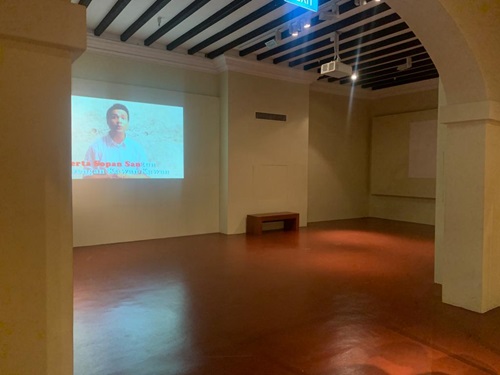
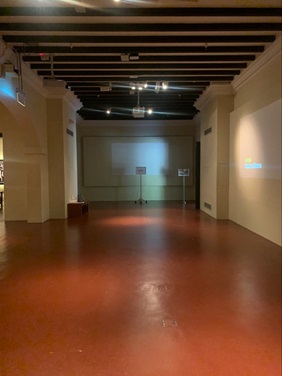
Located at the tail-end of
the museum on the first floor, the Finale gallery is the last gallery
that visitors encounter before they leave the museum. Thus, the design
took this into consideration: visitors will encounter the introduction panel to the Children’s Space either via the long walkway or MHC’s main entrance.
The 80 square metre space also needed to be transformed into an area that introduces Malay culture not only through its narration but also through elements of interactive exploration. It needed to not only look, but function differently from any other exhibit or display in the space. At the same time, the design needed to be versatile and serve more than one function given the limited area. The design is therefore twofold: it simulates environments that reflect the narrative of each historical character, while also targeting various motor skills of the child.
To translate a historical narrative into something that was relatable to young audiences, the focus on the stories and experiences of these young historical characters was important. Interesting points were picked up from the characters and woven distinctly into each of the spaces.
Ali Wallace was a 15 years old boy from Sarawak who supported renowned naturalist and explorer Alfred Wallace when he was travelling within the Malay Archipelago on various expeditions. It is believed that he was instrumental to Alfred Wallace’s research as evidenced from his personal records, publications and letters. One of Ali’s key contributions was the collection of bird specimens as he might have collected the majority of Alfred Wallace’s bird specimens, making a major contribution to the understanding of the plants and animals in the Malay Archipelago. One of the major discoveries he made was the Wallace’s Standard Wing (Semioptera Wallacii).
Drawing inspiration from his story, and the concept of versatile spaces, an inverted seating structure resembling a bird’s nest was designed. Not only does it cater to the school groups visiting MHC for their learning journey programmes, it also functions as a safe area for toddlers to crawl and explore. The ‘bird’s nest’ structure can comfortably sit a group of 20 students and provides a space for them to work on their activity booklets.
The activities in that space include puzzles made from soft cushions that encourage fine-motor skills of younger children as they try to form and match images of birds. This experience is further enhanced with textures and actual bird call recordings which are played throughout the space to simulate the natural environment. This is coupled with illustrations of trees as the backdrop with tactile elements such as artificial leaves, which children can observe, or even touch and feel to learn about different textures and shapes. These additions are carefully considered and placed at various height, so children are free to explore them. The tactile experience extends onto the carpet grass used to demarcate the Children’s Space. This unique feature sets the Children’s Space apart from the rest of the museum as it creates a truly immersive environment when visitors step on the grass barefooted, as if entering a forest oasis.
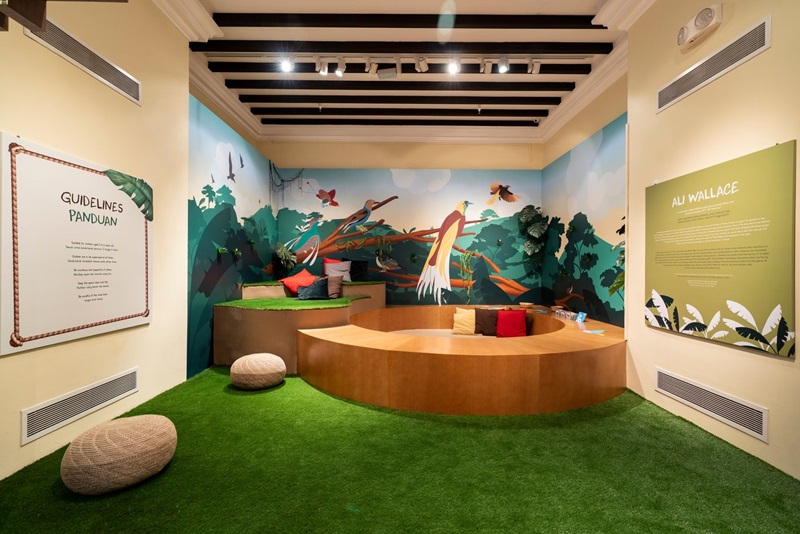
On the other end of the space, the story of Hang Nadim unfolds. This is the narrative of Bukit Merah (Red Hill) or the attack of Singapura by garfishes and is perhaps one of the most well-known local folktales. Like the past arts spaces in TAG, the team has been working with creatives to design exploratory structures which children can crawl through, over and under. This creates multiple uses for one structure with its various access points, while catering to various age groups. In this case, a mini hill-shaped structure covered with felt material was the main feature of Hang Nadim’s area. A tunnel is bored right through the hill for the little ones to crawl through. At the same time, there are multiple ways to interact with the structure and children are welcome to explore and come up with different ways to engage with the design. Accompanying this structure is an illustration of swordfishes as a backdrop, coupled with an artificial banana plant on the side, which features prominently within the story of Bukit Merah. How about using the space as a dramatised storytelling corner?
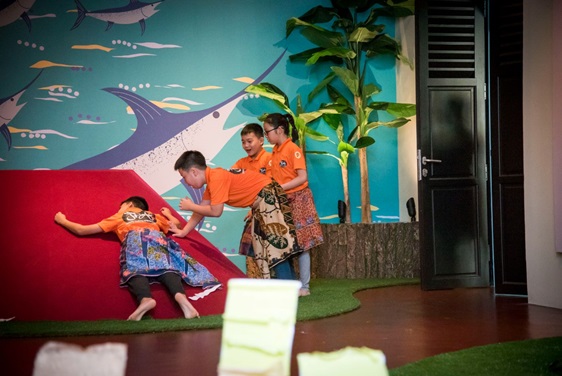
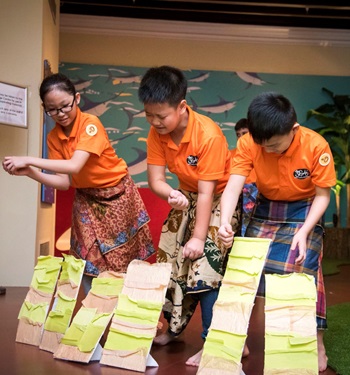
In the middle of the children’s space sits a reading corner that is designed to look like the porch of a traditional Malay house. It is also filled with books from the National Library, that are curated to suit the narrative of the space. This cosy corner is great for children to wind down or delve further into the stories related to, or about Singapore. It also provides opportunities for families to delve into diverse topics related to the narrative. Apart from some quiet reading time, Wayang Kulit puppets are also propped along the veranda of this house for visitors to interact with while they attempt to put up their own shadow puppet show. This is a great avenue for imagining and storytelling. Naturally, the house also hosts regular storytelling programmes which are organised by MHC for young families to enjoy.
Last but not the least, we have an interactive board designed based on the final character, Wah Hakim. Little is actually known about Wah Hakim, a 15-year-old boy, who was an orang laut (sea nomad) from the kelumang tribe in the region. He witnessed Sir Stamford Raffles’ arrival in Singapore and his account has been cited extensively by researchers and historians to understand what happened at that point of time. His account also gave us a glimpse of what Singapore was like then.
“At the time when Tuan Raffles came, there were under one hundred small houses and huts at the mouth of the river [Singapore]; but the Raja’s house was the only large one, and it stood back from the river […]. About half the ‘Orang laut’ lived ashore and half in boats […]. The men that lived in boats were the first to see Tuan Raffles coming. I remember the boat landing in the morning.”
Taking a leaf from his account, an interactive board with various elements was designed to bring that prominent scene to life. To children, it would seem like a larger-than-life page out of a storybook. The interactive elements are not only visually attractive, but also function as learning aids for the children. For example, they can move cubes (with seashell images) that function like an abacus, to facilitate in their learning to count. Topics on waves and wind can be facilitated as they push the movable boats that ferry Raffles towards the shore. Other parts include a magnetic board coupled with magnets that looks like fishes. For adults who are interested, they can read Wah Hakim’s full account of the arrival can be found in Gallery 2 of ‘Seekor Singa, Seorang Putera dan Sebingkai Cermin: Reflecting and Refracting Singapura.

Parents and families can see this Children’s Space as an avenue for exploration and play. While children are encouraged to take ownership of their learning in the Children’s Space, adults also have a critical role to play in facilitating a connection with the learning, depending on the needs of the children. To further facilitate the introduction of these characters, bilingual text is available for reference at each dedicated corner.
Despite being in a heritage site and museum gallery setting, the conventional rules and stipulated behaviour do not apply in this area and free exploration is encouraged. There is no one way to explore the space, and engagement with creativity is encouraged. It is believed that through immersive interaction, young families will deepen their interest in Arts and Culture.
Families and teachers are encouraged to continue their experience in Anjung Gallery, Gallery 1 and Gallery 2 to understand more about these young characters and explore interesting artefacts related to them.
Accompanying educational resources designed in a narrative format based on the characters are also available to complement the children’s experience of the space. The activity booklets are available in English or Malay and can be picked up at the Children’s Space (Ali Wallace’s section), visitor services centre or Gallery 1.
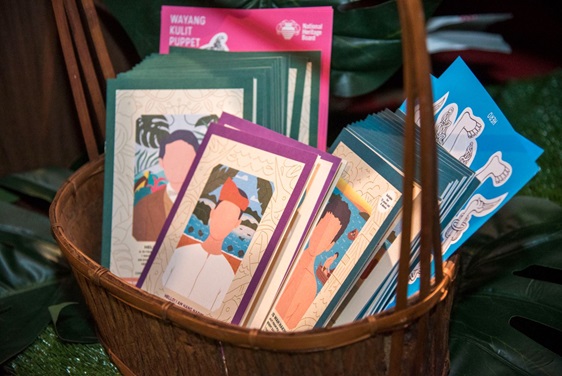
Apart from that, Malay Heritage Centre also organises monthly storytelling sessions, as well as regular craft and guided tours as part of the “Tales from the Nusantara” series of programs to further facilitate meaningful play-based activities between families.
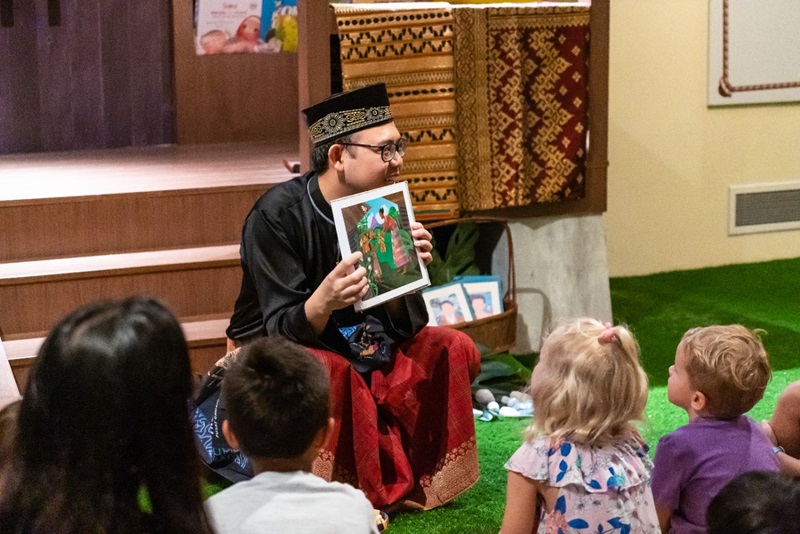
For more information about the upcoming sessions, visit the Malay Heritage Centre’s website or Facebook. We would also love to hear more about your experiences in the space and welcome you to write to us or connect with us on social media.